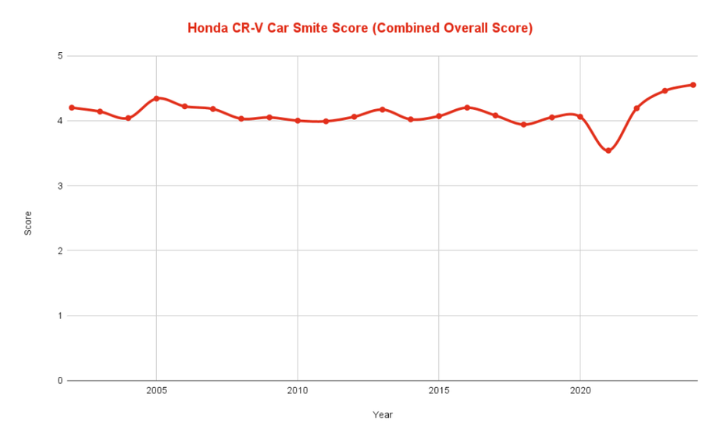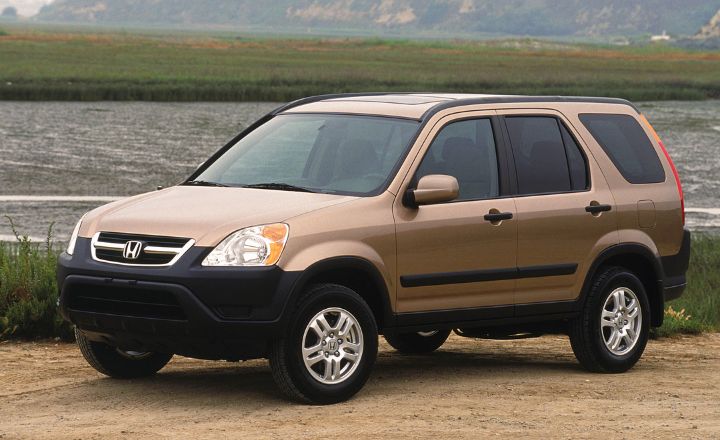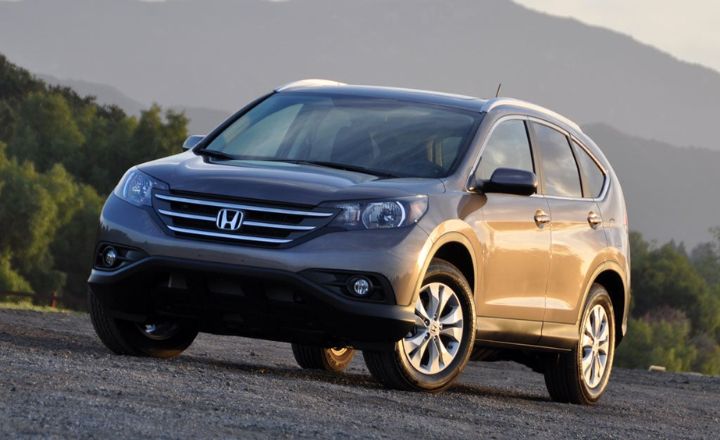The Honda CR-V has been a mainstay in the compact SUV market for over two decades, offering reliability, versatility, and comfort to drivers worldwide. Not all model years are created equal.
We will delve into the best & worst Honda CRV years, exploring its performance, features, and overall value. Understanding which model years shine and which ones fall short can help you make an informed decision to buy when it comes to this popular vehicle.
Honda CR-V Generations
The Honda CR-V is the best compact SUV in the market. It was introduced in the 1990s. They gain priority very quickly in utility, reliability, and efficiency.
For easier understanding, we explain the generations of Honda CRV from 2002.
| Generations | Years |
| 2nd generation (RD4-RD9) | 2002-2006 |
| 3rd generation (RE1-RE5, RE7) | 2007-2011 |
| 4th generation (RM1-RM4, RE5-RE6) | 2012-2016 |
| 5th generation (RW1-RW8, RT5-RT6) | 2017-2022 |
| 6th generation (RS) | 2023-Present |
Honda CR-V Best, Neutral, and Worst Years:
Several factors are crucial in ranking and categorizing the Honda CR-V model years.
- Owner-reported reliability (surveys)
- Annual maintenance costs
- Safety ratings
- Consumer Reports reliability scores
- Consumer Reports owner satisfaction scores
- NHTSA recalls, investigations, and complaints
- Edmunds owner ratings
- JD Power owner ratings
- Kelley’s Blue Book (KBB) owner ratings
- VehicleHistory owner ratings
- Cars.com owner ratings
Below is the graph of overall views of each performance.

Below is a table summarizing our categorizations to help you make an informed choice when you buy a Honda crv
| Generation | Best Years | Neutral Years | Worst Years |
|---|---|---|---|
| 2nd generation (RD4-RD9) | 2005 2006 | N/A | 2002 2003 2004 |
| 3rd generation (RE1-RE5, RE7) | 2009 | 2010 2011 | 2007 2008 |
| 4th generation (RM1-RM4, RE5-RE6) | 2013 2016 | 2012 | 2014 2015 |
| 5th generation (RW1-RW8, RT5-RT6) | 2022 | 2019 2020 | 2017 2018 2021 |
| 6th Generation | 2023, 2024 | N/A | N/A |
The Honda CR-V has been known for its balanced performance and is a safe choice for undecided buyers. NHTSA recalls have hurt the car’s rating, leading to lower reliability and decreased scores.
Considering the specific years of the Honda CR-V, it’s important to conduct a detailed review of specifications, features, and potential issues to determine which years are the best, neutral, or worst choices for prospective buyers.
Best & Worst Honda CRV Years For 2nd Generation (2002-2006)
The second generation of the Honda CR-V, from 2002 to 2006, had highs and lows.
The Best Years for Honda CRV: 2005, 2006
The best years for the Honda CR-V are generally considered to be 2005 and 2006. These models showed improvement over their predecessors, with a decrease in engine problems by 2005.
They are known for their comfort, spacious interior, and overall reliability. The 2005 and 2006 models stand out as the best in the second generation of Honda CR-Vs.
These particular years are highly recommended due to their improved performance and decreased likelihood of engine issues. If you’re looking for a reliable and comfortable SUV, the 2005 and 2006 Honda CR-V models are solid choices within the second-generation lineup.
READ More: Best & Worst Toyota RAV4 Years
The Worth Years for Honda CRV: 2002, 2003, 2004
The 2002 and 2003 models did have some trouble with airbags, AC, and engine problems. The 2002 model had AC compressor issues that could lead to costly repairs, while the 2003 model had a recall for shift cable corrosion that could cause accidents.

It’s worth noting that in 2019, there was a recall for 2002-2006 CR-Vs due to airbag inflator concerns. Second-generation CR-Vs seem to have more recalls.
It’s crucial to check the VIN for any potential issues before purchasing. It’s always better to be safe than sorry regarding car safety and reliability.
Best & Worst Years for Honda CR-V 3rd Generation (2007-2011)
The 3rd generation Honda CR-V, from 2007 to 2011, had highs and lows. This model boasts a sleek urban design and better fuel efficiency, making it a popular choice for city dwellers looking for a reliable and stylish SUV. The increased interior space was also a big plus, offering more room for passengers and cargo.
The Best Year For Honda CRV: 2009
The best year for Honda CRV would be the 2009 model in 3rd generation. It had fewer problems than other models of the same generation and carried over the virtues of comfort, reliability, and practicality from its predecessors.
It stood out because there were fewer complaints about airbags and electrical issues, making it a standout model regarding safety and reliability.
The Neutral Years For CRV: 2010, 2011
The 2010 and 2011 CRV models are generally considered neutral regarding reliability. They had fewer major issues compared to the 2007 and 2008 models. Some owners did report a persistent rear-differential fluid issue from the second generation, so that’s something to keep in mind.
There were occasional complaints about faulty AC compressors and steering fluid leaks, but these models have fewer significant issues overall.
The Worst Years for Honda CRV: 2007, 2008:
2007 and 2008 were Honda CRV years to avoid because were troubling times for CR-V owners, as many issues plagued the popular vehicle. From high complaints about airbags and electrical issues to reports of unwanted acceleration, it was clear that there were serious safety concerns at play.
Lock actuator failures added to the fray, causing doors to lock and unlock while driving, amplifying driver and passenger safety worries. Even a recall in 2019 for improperly installed passenger airbag inflators failed to fully alleviate concerns, leaving many uneasy about the car’s security features.
The list of problems didn’t end there. Reports of unintended acceleration raised fears for drivers’ safety and wallets, with potential hefty repair bills looming overhead.
Adding insult to injury was the revelation that under-inflated airbags could pose a serious risk to occupants, an alarming discovery that further eroded trust in the vehicle’s reliability. These consecutive years were trying times for CR-V owners grappling with many concerning issues that put their safety on the line.
Best & Worst Years for Honda CR-V 4th Generation (2012-2016)
The 4th generation Honda CR-V, spanning from 2012 to 2016, has had highs and lows. The best Honda CRV years models are generally considered 2013 and 2016. The latest CRV features a sleek design, advanced technology, and a focus on safety and fuel economy.
The Best CRV Years: 2013, 2016
The 2013 and 2016 Honda CR-V are both solid choices, each with advantages. The 2013 model has been praised for its dependability and fewer mechanical issues, making it a reliable option for those looking for a low-maintenance vehicle. It also integrated new tech and safety features, providing passengers with a smooth drive and comfortable ride.

The 2016 model addressed some of the issues seen in its predecessor, with fewer engine-related complaints and an improved infotainment system. The added safety features make it a strong contender in terms of overall safety. Both years have their strengths.
The Neutral Year: 2012
The 2012 CR-V introduced new aesthetics and features for the fourth generation but is less high-performing or reliable than the 2013 and 2016 models. It didn’t have the severe issues of the 2014 and 2015 models, making it a middle-of-the-road option.
If you prioritize performance and reliability, consider the 2013 or 2016 models instead. Remember that individual experiences may vary, so it’s important to thoroughly research and test drive any vehicle before deciding.
The Worst Years: 2014, 2015
Various issues have plagued the 2014 and 2015 model years for Honda vehicles. The 2014 models experienced problems with lock actuators, tire pressure sensors, and VTC actuator grinding noise.
The 2015 CR-V had issues with engine stalling, noise, and idling shudder. Despite attempts to address these issues through PCM updates and tailgate damper kits, the problems were only partially resolved.
There have been complaints about soy-based wiring attracting rodents and malfunctioning heaters in these model years. The 2014 and 2015 Honda vehicles have faced significant reliability challenges, making them some of the worst years for Honda CRV in recent memory.
Best & Worst Years for Honda CR-V 5th Generation (2017-2022)
The 5th generation Honda CR-V has generally received positive reviews since its launch in 2017. They introduced an edgier design and modernized technology suite. These early models also demonstrated improved performance dynamics, showcasing Honda’s intent to lead in the SUV segment.
The Best Year CRV: 2022
The 2022 Best Year CRV In the SUV market. With its focus on addressing past concerns and introducing new features, it’s clear that Honda has been listening to customer feedback and working hard to improve. The optimal balance of reliability, performance, and technological integration makes it a sought-after choice for many SUV enthusiasts.
Seeing fewer reported issues with the 2022 CR-V is great, which speaks to Honda’s dedication to delivering a high-quality vehicle. Its favorable reception further solidifies its position as a top contender in the SUV segment.
The Neutral Years: 2019, 2020
The 2019 Honda CR-V refined its performance and addressed previous concerns, with notable improvements in engine performance and safety measures. It fell short of achieving the excellence of the 2022 variant.
The 2020 Honda CR-V was positioned as a transitional model within the generation, striving to strike a balance between different aspects. Introducing a hybrid variant also showed Honda’s commitment to sustainable mobility, which is always a plus.
Both the 2019 and 2020 Honda CR-Vs made significant strides in improving their performance and safety features. While they may not have reached perfection, they laid the groundwork for future advancements and demonstrated Honda’s dedication to innovation and sustainability.
The Worst Years: 2017, 2018, 2021
The Honda CR-V faced a series of challenges in 2017, 2018, and 2021, with various models experiencing issues related to the electrical system, engine, powertrain, and service brakes.
Owners reported concerns like engine stalling, unpredictable dashboard lights, and safety worries. The 2018 CR-V was particularly affected by problems with the service brakes, leading to unexpected engagement. The 2021 CR-V also received a low rating of 1.9 out of 5 on vehiclehistory.com due to persistent issues, especially unpredictable brakes.
Potential buyers must know these reported issues when purchasing a Honda CR-V from these model years. Researching consumer reviews and seeking expert opinions can provide valuable insights into the reliability and performance of these vehicles.
Honda CRV 6th Generation (2023-Present)
The 2023 model develops its game with enhanced safety features, an efficient hybrid system, a spacious interior, and improved connectivity. Honda prioritizes safety and comfort while also keeping an eye on environmental concerns.
Moving onto the 2024 model, Honda is not resting on its laurels. With advanced pedestrian detection, a new e-AWD system, aesthetic tweaks for that extra flair, and a promise of reliability and innovation. They’re pushing the boundaries of what an SUV can be.
With both models promising reliability, innovation, and overall customer satisfaction, real-world data will be crucial in uncovering any potential issues or notable highlights of these vehicles.
Despite all the promises made by manufacturers during launch events or in their glossy brochures, there’s nothing quite as telling as feedback from actual users on the road.
Honda CR-V Reliability:
The Honda CR-V is well-known for its reliability and durability, earning an impressive overall rating of 4.5 out of 5.0 on dchkayhonda. This high rating reflects the vehicle’s reputation for being a dependable and long-lasting option in the compact SUV category.
Owners often praise the CR-V for its low maintenance costs, minimal repairs needed, and solid build quality that can withstand daily use and various driving conditions.
Honda CR-V Average Resale Values:
The Honda CR-V is known for holding its value well in the resale market. With its reputation for reliability and fuel efficiency, it’s no surprise that it maintains a strong resale trajectory like other models of the Hyundai Tucson years. Buyers often pay a premium for a used CR-V due to its long-term durability and overall desirability. Below is a comprehensive graph of the average sale values of the Honda CR-V.

Final Words:
The Honda CR-V has seen its fair share of ups and downs. While some models have excelled in reliability and performance, others have fallen short. It is important for potential buyers to carefully consider the specific model year before making a purchase.
Thorough research and careful consideration are crucial when determining which Honda CRV year best fits individual needs. Make sure to weigh all factors before making a final decision.
FAQ’s:
What year Honda CR-V should you avoid?
You should avoid 2002, 2003, 2004, 2007, 2008, 2014, 2015, 2017, 2018, and 2021 Honda CR-V models due to a higher incidence of transmission problems and much more.
What year Honda CR-V should I avoid?
The Honda CR-V model years to avoid based on common issues reported by owners and mechanics are 2002, 2003, 2004, 2007, 2008, 2014, 2015, 2017, 2018, and 2021. These years have been associated with transmission problems, air conditioning issues, and excessive oil consumption.
What are the Best years for Honda CRV?
The Honda CRV has seen several best years, but some standout models include the 2005, 2006, 2009, 2013, 2016, 2022, 2023, and 2024 versions known for their reliability and performance.

